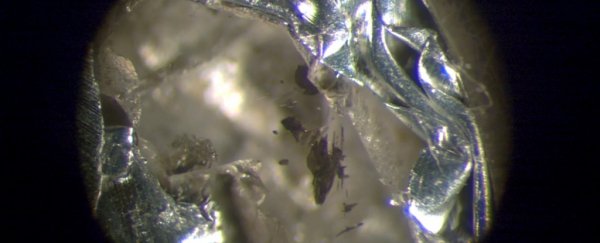For the first time, scientists have found calcium silicate perovskite (CaSiO3) on the surface of Earth.
It may be the fourth most abundant mineral on Earth, but it had never been seen before by human eyes in nature - because above a depth of about 650 kilometres (400 miles), it becomes unstable.
So how did it manage to survive the ascent? It was contained inside a tiny sliver of diamond. The gemstone was recovered from less than a kilometre deep into Earth's crust, at South Africa's Cullinan diamond mine.
"Nobody has ever managed to keep this mineral stable at Earth's surface," said geochemist Graham Pearson from the University of Alberta's Department of Earth and Atmospheric Sciences.
"The only possible way of preserving this mineral at Earth's surface is when it's trapped in an unyielding container like a diamond."
Scientists have estimated that silicate perovskites constitute as much as 93 percent of Earth's lower mantle, but CaSiO3 had remained hypothetical up until this point. Now that we have our hands on this mineral, scientists will finally be able to study it in more detail.
The diamond it was found inside, just 0.031 millimetres across, is also a super-rare specimen.
Most diamonds are born much closer to Earth's surface, between 150 and 200 kilometres (93 and 124 miles) deep. But this particular diamond would have formed at a depth of around 700 kilometres, the researchers said.
At that depth, the pressure is around 240,000 times that of atmospheric pressure at sea level.
It was this intense, crushing pressure that would have formed the diamond, trapping the CaSiO3 inside by creating a stable case for it, and preventing the mineral's crystal lattice from deforming as the diamond moved towards the surface.
Already, the discovery has revealed fascinating information about how Earth's mantle formed.
"Diamonds are really unique ways of seeing what's in the Earth," Pearson said.
"And the specific composition of the perovskite inclusion in this particular diamond very clearly indicates the recycling of oceanic crust into Earth's lower mantle. It provides fundamental proof of what happens to the fate of oceanic plates as they descend into the depths of the Earth."
The research team polished the diamond, and conducted spectroscopic analysis to confirm that the mineral inside is, indeed, the elusive CaSiO3. In the next phase, researchers from the University of British Columbia will be working to find out more about its age and origin.
The team's paper has been published in the journal Nature.
